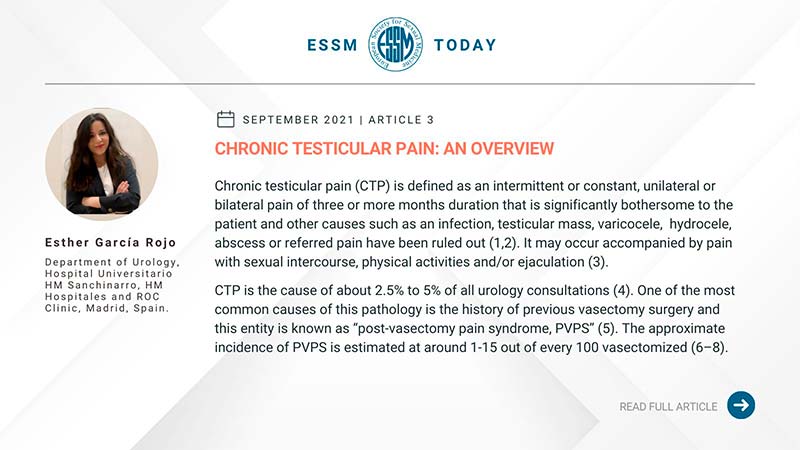The European Society for Sexual Medicine (ESSM) has published in its latest newsletter, ESSM Today, an article about chronic testicular pain, written by Dr Esther García-Rojo .
Chronic testicular pain is defined as an intermittent or constant, unilateral or bilateral pain of three or more months duration that is significantly bothersome to the patient and other causes such as an infection, testicular mass, varicocele, hydrocele, abscess or referred pain have been ruled out. It may occur accompanied by pain with sexual intercourse, physical activities and/or ejaculation
This disease is the cause of about 2.5% to 5% of all urology consultations . One of the most common causes of this pathology is the history of previous vasectomy surgery and this entity is known as ‘post-vasectomy pain syndrome, PVPS’. The approximate incidence of PVPS is estimated at around 1-15 out of every 100 vasectomized.
Other recognized causes of chronic testicular pain are inguinal hernia surgery, abdominal surgery, diabetic neuropathy and imipramine used as an antidepression treatment. In patients with hyperuricemia, intracanalicular deposition of uric acid crystals with consequent disruption of the nerve endings has been suggested as the cause of this condition. Some patients relate the onset of their chronic testicular painto some kind of injury. his could be explained by the phenomenon of neural plasticity. In neural plasticity, injury can cause changes at all levels of the nervous system, so pain messages are amplified. […]
Diagnostic and treatment of chronic testicular pain
For a proper diagnostic approach, a good anamnesis is necessary, recording the date the pain onset, concomitant diseases, previous surgeries and possible triggers, as well as the type of pain, location, intensity, irradiation and triggering or other aggravating factors.
Although there are potential causes of chronic testicular pain, such as epididymis congestion, infection or varicocele, most of these can be ruled out with a complete medical history, physical examination and urinalysis. When these analysis are normal, the diagnosis is less clear and the neurogenic causes of pain must be considered. If there is no suspicion of infection, treatment with empirical antibiotic therapy is not indicated.
Scrotal ultrasonography is usually part of the patient’s evaluation with scrotal pain. However, in the absence of significant clinical findings on physical examination and in the presence of a negative urinalysis, the real benefit of scrotal ultrasound is to reassure the patient concerned about cancer.
Currently, the treatment of chronic testicular pain is largely empirical because of the absence of standardized protocols and it occupies a considerable part of most urologists’ time.
Chronic testicular pain typically presents a poor response to usual analgesic drugs and as a first line of treatment, low doses of anxiolytics or tricyclic antidepressants (amitriptyline, dapoxetine and nortriptyline) can be used with good rates of pain reduction. Neuromodulating drugs such as gabapentin that provide significant pain reduction in up to 80% of patients may also be used. […]
You can read the complete article about chronic testicular pain, published in the latest ESSM Today.

